
 |
| The most famous or well known Incan ruins is of course Machu Picchu. While some will argue that other Incan ruins have finer or more impressive stonework and held higher importance in the Incan Empire, there is something about Machu Picchu that makes it an incredible place to visit. |
 |

| To get a great overview of Machu Picchu, you should hike up to various spots around the ruins. Huayna Picchu, the tall peak visible in the doorway (and the above photo) provides an incredible view of the entire area. |
|
Machu Picchu is located high above the Urubamba river valley. Small pictures just cannot show the scale so click here to view a larger version of this picture.
I find it amazing that the Incas built structures and terraces on many high points around city including Huayna Picchu. |
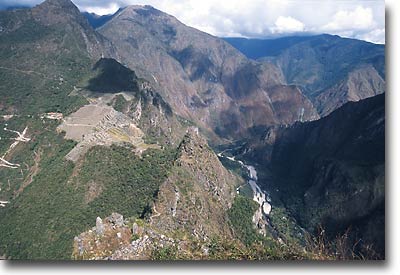 |
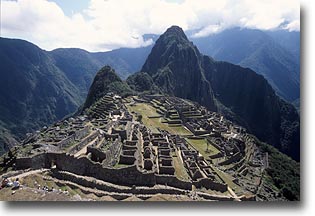
| Of course the best views of the city (or perhaps I should say the ones found on most post cards) are taken from the opposite direction, |
| I am often amazed at how slight changes in lighting can so often completely change the feel of scene. |
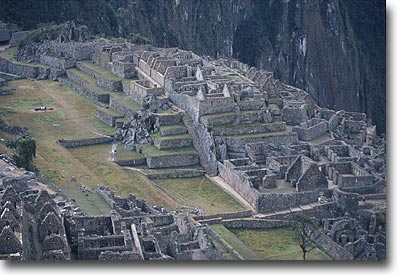 |
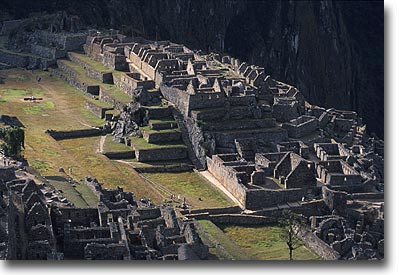 |
As you may or may not have noticed, this is the exact same picture as before, but taken a few seconds later with direct sunlight. If you look carefully, you'll be able to see how little people moved between the two photos.
Click here to see a larger version. |
| The challenge when photographing a place that has been photographed millions of times by countless numbers of people is to come up with something new or different. |
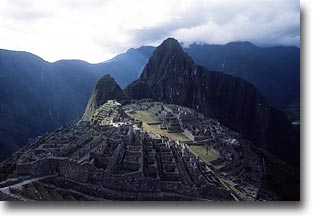 |
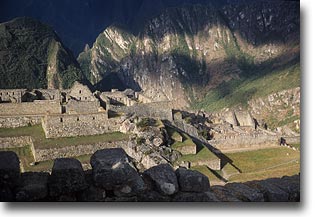 |
Quite often the only way you'll get a unique shot is to find a new vantage point or better yet, wait around for some unique lighting or weather. I really love shooting late in the day when there is direct sunlight and shadows from clouds. |
|
The challenge is of course is to find a good place and have enough patience to wait around for the sun to hit the right spot. It is even tougher when you are only going to be in one location for a few hours and you want to make the most of your time.
If I'm going to be in one place for a day or two, I try to make a mental list of spots I want to return to later in the day or the next morning to catch some better light. |
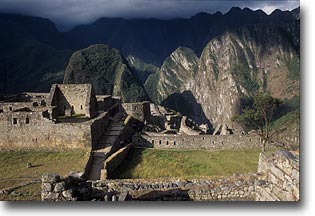 |
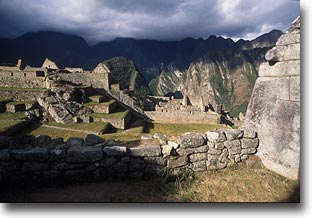 |
But quite honestly, many times something catches your eye and you try to get it on film and make minor position or framing adjustments before the "magic" disappears.
By now you must be wondering when I'm going to explain something about Machu Picchu's history. OK, but understand that there is a lot of confusion about Machu Picchu. |
|
Hiram Bingham is generally credited for "discovering" the site on July 24, 1911. Bingham really felt that Machu Picchu was the lost city of Vilcabamba, the legendary final refuge of Manco Inca and his sons from the Spanish. As a result, Bingham interpreted findings at Machu Picchu to match written historical accounts about Vilcabamba. He also published several books on the subject with views that exist and continue to permutate in various forms today.
I overheard one person state that no male bodies were found buried at Machu Picchu. So the city was perhaps an enclave of virgins, or holy women, or something like that. (Originally proposed by Bingham) |
 |
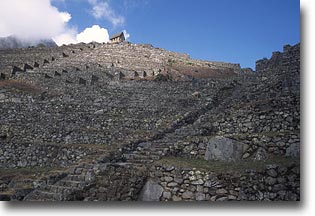 |
According to John Hemming's book "The Conquest of the Incas", 3/4 of the bodies found during Bingham's original excavation were female. Hemming notes that the figure itself may be suspect to a certain extent as it includes only those skeletons that George Eaton of the Peabody Museum was able to determine gender and that he did so correctly. I would add that one should remember that the Incas were very expansionistic. They spent a lot of time and human resources conquering tribes to the north and in Ecuador. In fact, when the Spanish arrived in numerous places, they noted the low ratio of men to women. |
|
The point being is that theories abound and factual information can be interpreted in various ways.
I figured I could always read more books about Machu Picchu, but I might never get back. So, I ditched the tour after 5 minutes and spent my time taking photographs in between hikes. That shows you where my priorities are I guess... Anyhow, probably the best thing to do is spend a couple of days and commit to not do any shooting until after taking the full tour. |
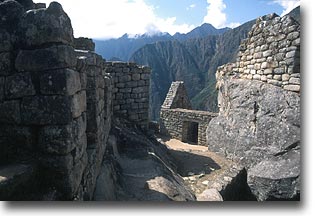 |
 |
If you do skip the tour, you need to make sure you don't miss significant places like the Andean Condor found amidst the ruins. In case you can't spot it, the two big angled rocks are the wings and the triangle shaped body and head with the carved beak is surrounded by ropes. This had some purpose of course and was obviously intentional as two carved white stones were placed forming the collar of the Andean Condor.
Underneath the wings is a small cave which believe it or not, was recently proven by an amatuer archaeologist to function as a solar observatory/calender. |
| A more obvious sun dial/solar calender can be found on the top of one of the pyramid type mounds. I kept waiting around trying to get a photo without tourists, as I really prefer tourist-free photos of Incan ruins. But tourists are all over Machu Picchu and spots like this one always have people on them. After 15 minutes or so, I gave up on the idea. |
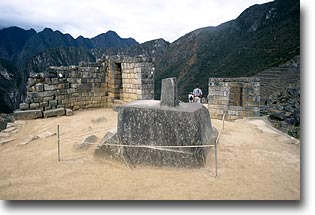 |
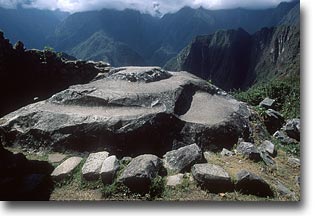
|
Machu Pichu is a great place to visit. If you have the time, there are number of short hikes to various spots and lookout points that are enjoyable. We found this carved lookout chair near a doorway and some rooms along the Incan road above the ruins.
For the more adventurous traveler, there are several day camping treks (with porters that carry your gear) along this Incan trail ending up at Machu Pichu. |
|
My recommendations. Don't try to visit in one day and spend at least one night.
If you can afford it, spend the night up at the hotel near the ruins. But, spending the night or several nights in Aguas Calientes is OK, (that's where we stayed) and you do have more restaurant options. Take the tourist train, not the slow really overcrowded freight train. Learn all you can about Machu Picchu beforehand and determine what you want to see and photograph. Take lots of film and wait for the right light, but don't focus so much on taking photos that you miss learning something new or enjoying your time there. |

|